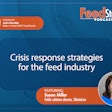Dr. Ferry Leenstra described the reflexive interactive design process to the audience at the Executive Conference on the Future of the American Egg Industry and how it has been used to come up with some unique housing alternatives for laying hens in the Netherlands. Both the Rondeel and the Plantation systems looked interesting and reportedly have addressed the concerns of both activists and consumers (see Dutch egg producers, researchers are seeking optimum layer housing in this issue). But neither system houses very many hens.
According to Leenstra, a Rondeel and a Plantation house 30,000 and 6,000 hens, respectively. Just imagine how many of each of these systems a farm would need in order to have an efficient egg washing, grading and packing facility. I could see these systems used to produce eggs for niche markets like organic production in the U.S., but not for the mainstream consumer table egg market in this country.
Enriched colony housing is scaleable, and these systems can be retrofitted into most existing houses in the U.S. Farms will necessarily have more square footage under roof to accommodate the current number of hens, but economies of scale in collecting, washing, grading and packaging of eggs would be maintained.
The idea for enriched colony housing originated in Europe, but this type of housing has not won over activists and consumers in all EU countries. Germany, Switzerland and the Netherlands have each enacted legislation to ban enriched colony “cages” for hens. These countries will move forward with cage-free production systems as the only choice for producers. Other northern EU countries, like England, have also seen a dramatic shift to cage-free production brought on by demands from retailers.
Preventing a forced move
As more U.S. egg producers adopt enriched colony housing it will be necessary for each producer to work to educate the public about the benefits of this type of housing for hens. Efforts like the in-house cameras at JS West, which is viewable via the Internet, need to be replicated at all farms with enriched colony housing. If the U.S. industry does not want to be forced into a completely cage-free future, then all houses need to provide an environment for hens that we are happy to have consumers view at any time.
The U.S. egg industry can still be forced into cage-free production if it does not successfully demonstrate the advantages of enriched colony housing for hens to consumers and other interested parties. Even if H.R. 3798 gets passed by both houses of Congress, the battle isn’t over. Preventing a forced move to all cage-free production will require the entire industry to make sure that they are ready for visitors every day. Processing plants must be ready for an audit every day, there is no reason that a modern laying farm can’t be operated the same way.















